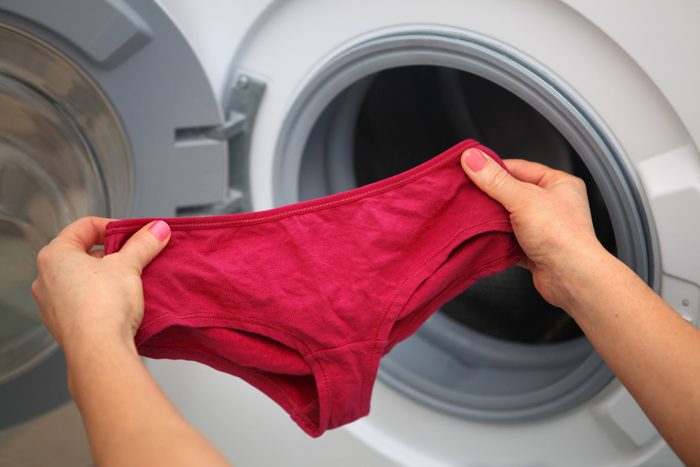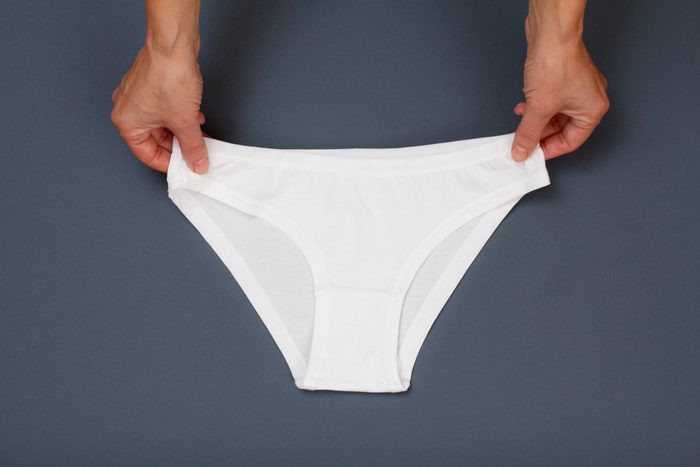
The crotch is not cotton
Ideally, every last inch of your underwear should be woven from these natural fibres, but at the very least, the centre stretch should be lined in cotton to keep your nether region fresh and dry. Research, including a study published in 2018 in Obstetrics & Gynecology, suggests that wearing non-cotton-crotch underwear can set you up for a yeast infection. Synthetic fabrics—like polyester and lace—can mess with your vaginal health by trapping heat and moisture, irritating the skin and creating an environment for bacteria or a fungus to overgrow and multiply. Silk (sorry) has the same effect. Save the fancy for special occasions, but otherwise stick with cotton.
“It’s a very breathable fabric that has the ability to reduce moisture,” says Jennifer Wider, MD, women’s health expert and author of The Savvy Woman Patient. “As a result, women who wear 100 percent cotton have less of a chance of vaginal irritation and yeast infections.”

The size is too small
Size matters—and not just because you don’t want panty lines. Tight-fitting undergarments (and pantyhose for that matter) can keep your lady bits hot and sweaty—and not in a good way, but more along the irritation- and infection-promoting lines. In some women, snug underwear can trigger symptoms of a painful condition known as vulvodynia (so can inserting a tampon and having sex). “If your underwear is too tight or too small, the chances of vaginal and vulvar irritation increases,” says Dr. Wider. So, too, does “the ability of bacteria to multiply if there isn’t enough opportunity for aeration.”

They come out of the washing machine less than clean…
Bacteria can survive a laundry cycle, suggests a study published in 2019 in Applied and Environmental Microbiology. Over time, that can do a number on your vaginal health, possibly increasing your chances of a yeast infection or urinary tract infection, among other conditions. If you wash your underwear on anything less than the “Hot” cycle, be sure to tumble dry them on low for 30 minutes after washing. A review of studies published in 2015 in Frontiers in Microbiology showed that cooler washing temperatures will disinfect only when bleaches are used in the detergents. It also found that a thorough drying of the laundry can effectively decrease the bacterial load. (Here’s what else could be irritating your vagina.)

…or smelling like flowers
Down-there skin can be sensitive and easily irritated by the perfumes used to give your laundry detergent its fresh scent. The chemicals in fabric softener and dryer sheets can also cause a little itch and burn. “Some women are more sensitive than others but on the whole, scented tampons and strong detergents can cause itching and irritation or even a burning feeling,” says Dr. Wider. Your best bet? “Avoid using scented detergent if you’ve had a reaction in the past.” Instead, the American Academy of Dermatology suggests looking for those labeled “hypoallergenic.” (Here are the foods your vagina needs you to eat.)

You despise visible panty lines
…which likely means you adore thongs. But in an effort to avoid visible panty lines, you may be providing a direct lane for bacteria to travel from the back door to the front, raising your risk of infection. “Some women may be able to tolerate thongs without a problem, but for others, it’s another story,” says Dr. Wider. “Many thongs come in lacy, synthetic fabrics with non-breathable materials that increase the risk for irritation and infection. The other issue women face is that thongs have a thin band of material which has the potential of moving bacteria from one area to another.”

You ignore the stains
Ewww all you want, but it’s still important to eyeball discharge to check for changes. There can be a little more, or less, depending on where you are in your menstrual cycle—but if it’s clear to white, it’s normal. Gray or greenish discharge, instead, could be a sign of bacterial vaginosis—an infection caused by an overgrowth of bacteria that normally live in the vagina. Discharge that looks like pus, or has a foamy or cottage-cheesy texture, may also indicate a problem. A little vaginal odor is normal, but strong, foul, and noticeable may mean infection or other issues. (Learn why Amy Schumer wants to talk about your period.)

You sit in your sweaty underwear
After yoga class or a workout at the gym, you head home to shower, but have to stop at the bank real quick, pick up a few groceries for dinner, grab a cup of coffee, and an hour later, you’re still in your icky workout undies. “It’s always a good idea to change after working out,” says Dr. Wider. That’s especially true if you’re not wearing moisture-wicking or cotton undies since “synthetic fabrics don’t breathe as well as cotton ones and can trap moisture and bacteria post-workout.”
That combo of warm and wet can irritate the skin on the outside of your vagina (the vulva), leading to inflammation; become a breeding ground for bacteria and yeast; and may raise your risk of intertrigo, a rash that can appear in skin folds and creases that’s caused by friction, lack of air circulation, and moisture. (You may also want to learn how summer could make you sick.)

You sleep in your skivvies
For most women, not a problem. For others, however, going commando at night might do their vagina good. Women who suffer from chronic inflammation of the vulva or vagina are prone to vaginal yeast infections, itchiness, and irritation, and are likely better off if they sleep without underpants, according to The American College of Obstetricians and Gynecologists. Since yeast and bacteria thrive in moist, warm places, a little aeration now and then may provide some relief. If you feel uncomfortable in the buff, opt for a loose pair of cotton underwear, or snag a pair of boxers from your partner’s drawer.
Next, check out the vaginal health myths your gynecologist wants you to ignore.
